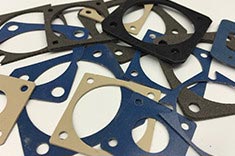EMI Shielding Products
- Custom Gasket Fabrication
- Connector Gaskets
- Bonded O Ring
- Custom Gaskets
- Conduct-O-Knit Knitted Wire Mesh
- Conduct-O-Seal Combo Gasket
- Conduct-O-Elastomer
- Conduct-O-Seal Oriented Wire in Silicone Gasket Material
- Conduct-O-Mesh Tape
- Conduct-O-Foam
- Conduct-O-Bond
- Optical Filters For Electronic Displays
- Shielded Vent Panels
- ESC Board Level Shielding
- 300 Series
The Impact of EMI Shielding Materials on Thermal Performance in Electronic Products
 EMI shielding can have an impact on thermal management in electronic product design. This is because the materials used for EMI shielding can have different thermal conductivity properties, affecting the dissipation of heat generated by the electronic components. To integrate EMI shielding with thermal management, designers need to consider the material properties and thickness of the shielding and the placement of the shielding in relation to heat sources.
EMI shielding can have an impact on thermal management in electronic product design. This is because the materials used for EMI shielding can have different thermal conductivity properties, affecting the dissipation of heat generated by the electronic components. To integrate EMI shielding with thermal management, designers need to consider the material properties and thickness of the shielding and the placement of the shielding in relation to heat sources.
EMI shielding materials can significantly impact the thermal performance of electronic devices. The report notes that metallic materials, such as copper or aluminum, can have higher thermal conductivity than other shielding materials, which can help dissipate heat more effectively. The article also suggests that designers should consider the placement of EMI shielding concerning heat sources and the thickness of the shielding to optimize both EMI shielding and thermal management.
Real-world examples of integrating EMI shielding with thermal management can be found in products such as laptop computers and automotive electronics. In laptops, EMI shielding for the display panel can also serve as a heat sink for the display backlight, which can reduce the overall temperature of the display and improve its performance. In automotive electronics, EMI shielding can provide electromagnetic protection and thermal management for sensitive electronic components that may be exposed to high temperatures.
How to Safely and Effectively Integrate EMI with Thermal Management?
- Understand the impact of EMI shielding materials on thermal performance: Different materials used for EMI shielding can have varying thermal conductivity properties, impacting heat dissipation in electronic components. It is important to understand these properties to integrate EMI shielding with thermal management effectively.
- Consider the placement of EMI shielding in relation to heat sources: The placement of EMI shielding can affect both its effectiveness in shielding against EMI and its impact on thermal management. Designers should consider the location of heat sources in relation to EMI shielding and ensure that shielding does not interfere with thermal management.
- Optimize the thickness and placement of EMI shielding: The thickness and placement of EMI shielding should be optimized to balance both EMI shielding and thermal management needs. This can involve a tradeoff between the level of EMI shielding and the amount of heat that can be dissipated.



